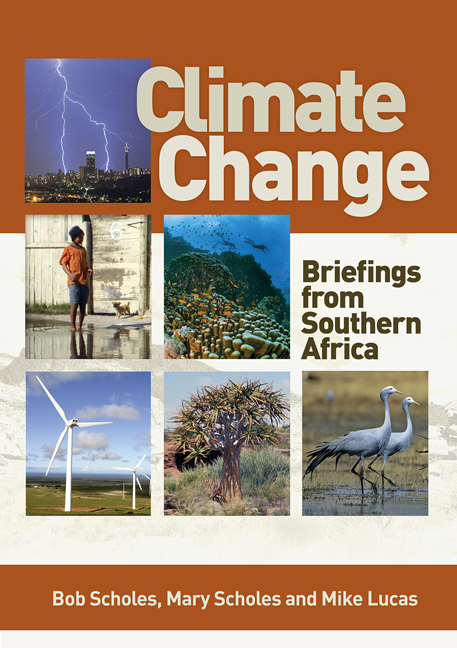Book contents
- Frontmatter
- Acknowledgements
- Contents
- Foreword
- Acronyms and abbreviations
- Preface
- How do governments assess climate change?
- Section 1 Earth system science: The processes that underlie climate change
- Introduction
- 1 Why is Earth habitable?
- 2 How do greenhouse gases regulate Earth's temperature?
- 3 Is water vapour the most important greenhouse gas?
- 4 Why are clouds the wild card in climate change?
- 5 Is climate change just part of a long-term natural cycle?
- 6 Are climate variations just due to volcanoes or other Earth processes?
- 7 How do El Niño and La Niña events affect South African weather?
- 8 How hot might it get in South Africa this century?
- 9 How might the rainfall in Southern Africa change in the twenty-first century?
- 10 Are extreme weather events related to climate change?
- 11 How do land-use changes and deforestation affect global warming?
- 12 What is South Africa's contribution to global warming?
- 13 What happens to carbon dioxide emissions?
- 14 Can ecosystems keep sucking up carbon dioxide from fossil fuel burning?
- 15 Could ocean currents slow down or change direction?
- 16 Is there any chance of runaway global warming?
- Section 2 Consequences of a changing climate for the Southern African environment
- Section 3 Consequences of a changing climate for society
- Section 4 What we can do to avoid and adapt to climate change
- Codicil Is there a dangerous level of climate change?
- Glossary
- List of figures
- References
- Reading list
- Index
8 - How hot might it get in South Africa this century?
from Section 1 - Earth system science: The processes that underlie climate change
Published online by Cambridge University Press: 20 April 2018
- Frontmatter
- Acknowledgements
- Contents
- Foreword
- Acronyms and abbreviations
- Preface
- How do governments assess climate change?
- Section 1 Earth system science: The processes that underlie climate change
- Introduction
- 1 Why is Earth habitable?
- 2 How do greenhouse gases regulate Earth's temperature?
- 3 Is water vapour the most important greenhouse gas?
- 4 Why are clouds the wild card in climate change?
- 5 Is climate change just part of a long-term natural cycle?
- 6 Are climate variations just due to volcanoes or other Earth processes?
- 7 How do El Niño and La Niña events affect South African weather?
- 8 How hot might it get in South Africa this century?
- 9 How might the rainfall in Southern Africa change in the twenty-first century?
- 10 Are extreme weather events related to climate change?
- 11 How do land-use changes and deforestation affect global warming?
- 12 What is South Africa's contribution to global warming?
- 13 What happens to carbon dioxide emissions?
- 14 Can ecosystems keep sucking up carbon dioxide from fossil fuel burning?
- 15 Could ocean currents slow down or change direction?
- 16 Is there any chance of runaway global warming?
- Section 2 Consequences of a changing climate for the Southern African environment
- Section 3 Consequences of a changing climate for society
- Section 4 What we can do to avoid and adapt to climate change
- Codicil Is there a dangerous level of climate change?
- Glossary
- List of figures
- References
- Reading list
- Index
Summary
A warming trend is already apparent in South Africa, and it is much higher than the global average rate. Thus, relative to the present, temperatures in the interior of the country could rise by about 3°C by the end of the century if the countries of the world greatly and urgently reduce their greenhouse gas emissions, but by up to 6°C if they do not.
The global average air temperature measured near the surface in 2010 has risen by 0.8°C since 1870 when accurate records began and, measured over multi-decade periods, the rate of warming has been accelerating. The rise in air temperature has been unsteady: there is a general upward trend interspersed by some long periods of no change, or even cooling. For instance, in the decade after 2000 there was little overall rise, just as there was little rise in the period 1945–1968, but in between were periods of rapid rise. Such pauses are to be expected when a complex system such as Earth's climate is nudged up, even if the nudging is relatively continuous, as the increase in greenhouse gases has been. Some of the cooling periods are associated with variable global weather patterns and specific events. Altered ocean circulation such as recurrent La Niña phenomena in the equatorial Pacific Ocean cools Earth, as do large volcanic eruptions that fill the atmosphere with reflective dust and sulphate aerosols. These eruptions can cool Earth's atmosphere by up to 0.5°C for two to three years. Tellingly, the heat content of the ocean, which is much larger than the heat content of the atmosphere, has kept going up. Despite the temporary cooling periods, there is a consistent overall upward trend in average global temperatures. The annual average air temperature in South Africa has risen by around 1.2°C over the period of accurate records.
In the medium term, global warming in the northern hemisphere will generally exceed that in the southern hemisphere because oceans, which dominate the southern hemisphere, warm more slowly than the land. Despite this, the rate of warming in South Africa is nearly twice the average rate recorded worldwide so far. This is partly because inland regions of South Africa are distant from cooling oceanic influences. It is also because much of South Africa falls within a dry belt broadly corresponding to the Tropic of Capricorn.
- Type
- Chapter
- Information
- Climate ChangeBriefings from Southern Africa, pp. 23 - 25Publisher: Wits University PressPrint publication year: 2015



